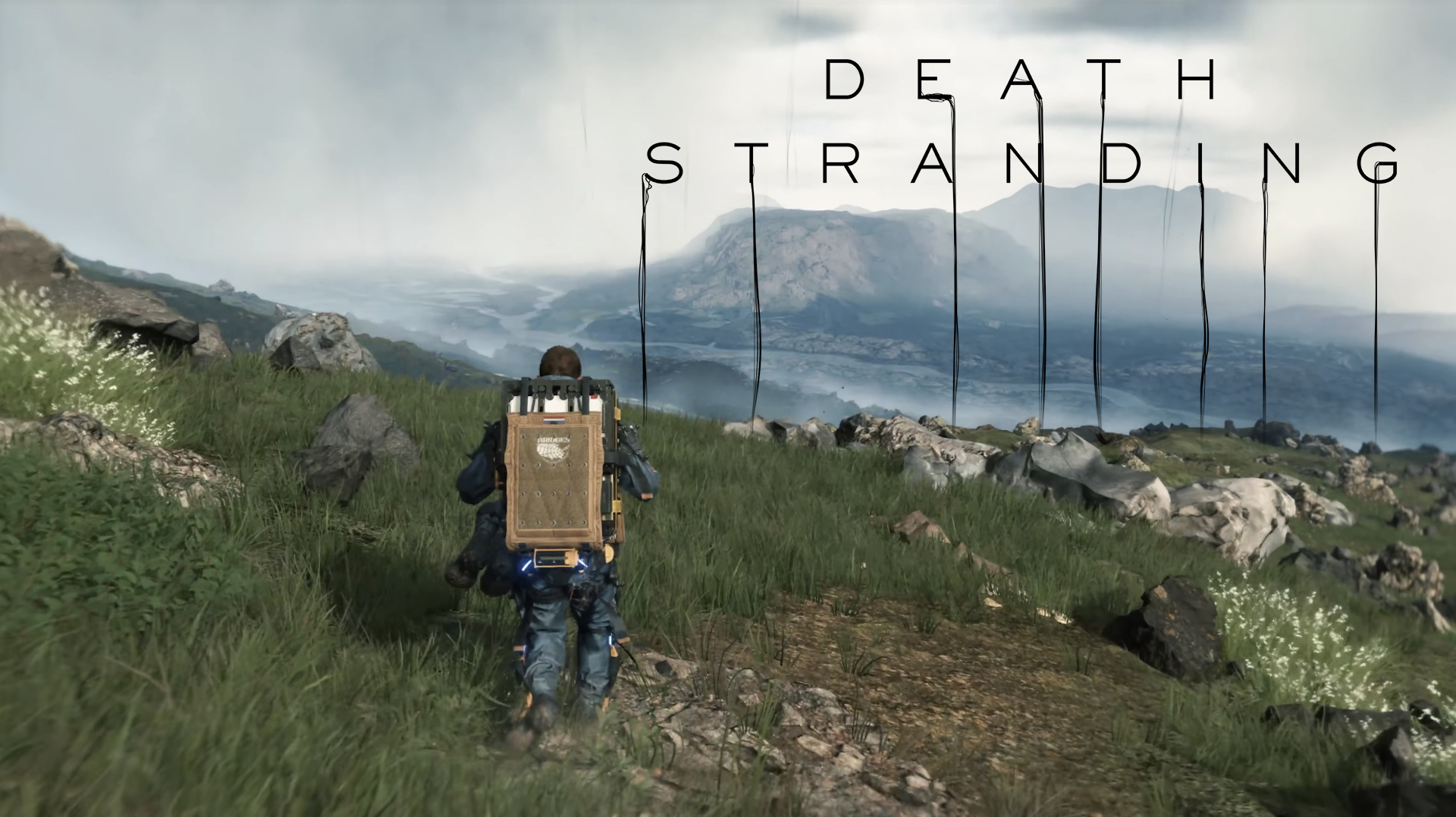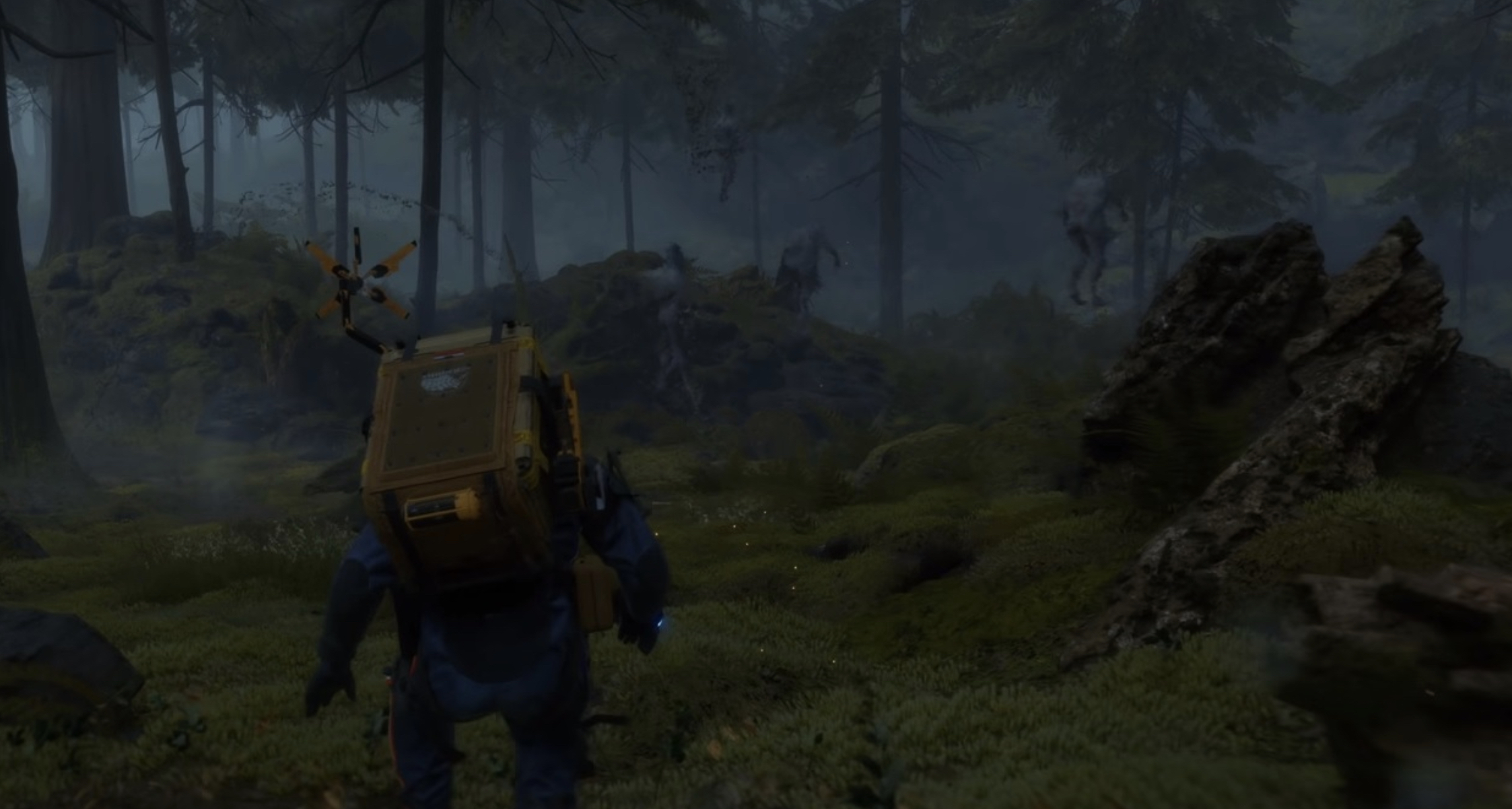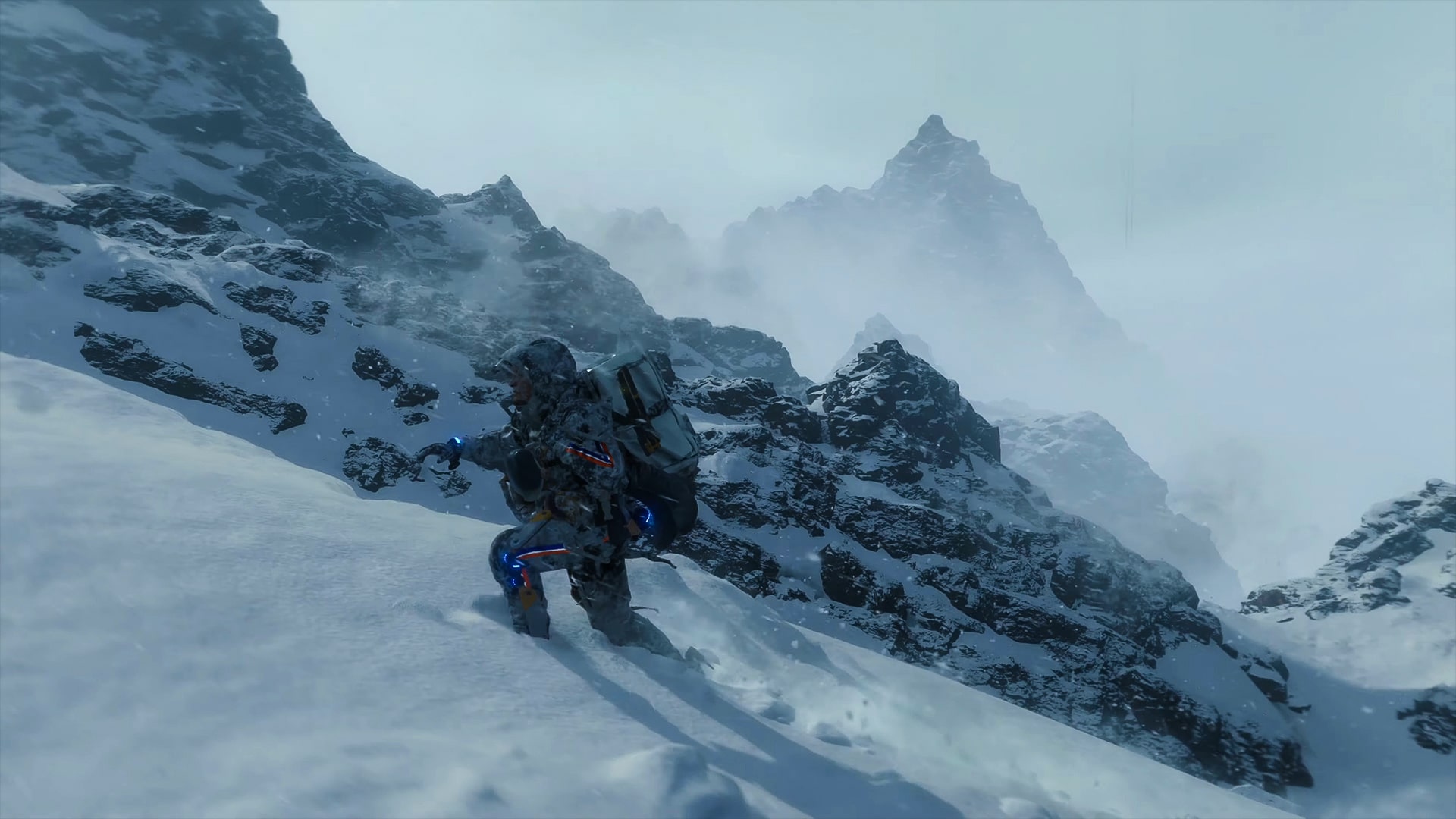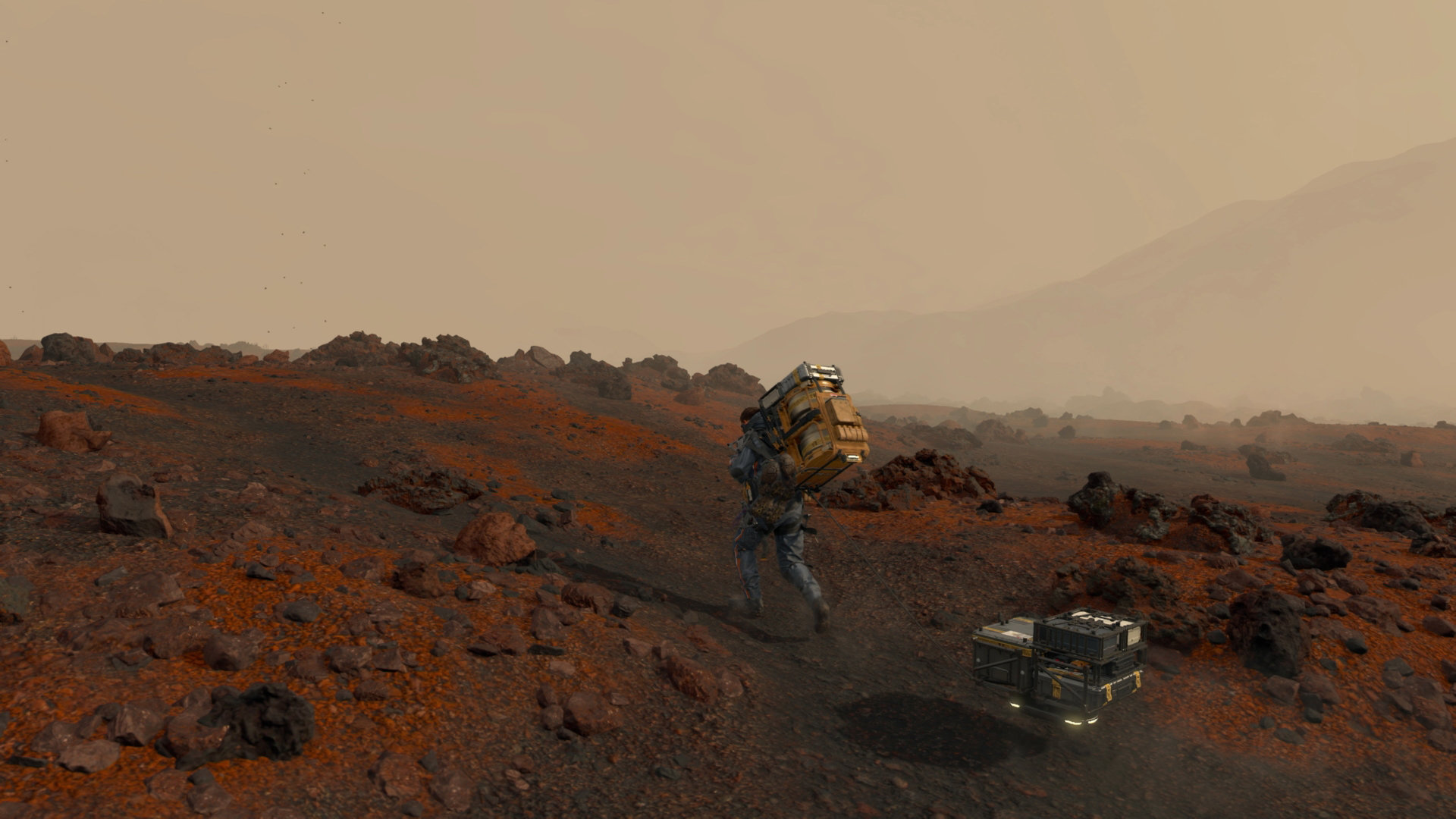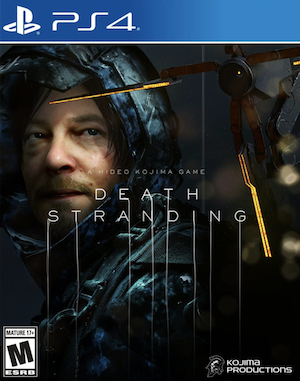
For years, Hideo Kojima has been a household name in the games industry, a pioneer of storytelling in video games and the godfather of the stealth genre. Now, after a clean break from Konami and all things Metal Gear, and with the reborn Kojima Productions by his side, he returns to the spotlight with a brand-new property in Death Stranding, a game that is cut from a very different cloth from his previous works.
You play as Sam Porter Bridges, a man who spends his days making deliveries from place to place, in a world where even stepping outside the bounds of what little civilization is left is nothing short of a death sentence. In the wake of a devastating extinction event, porters like Sam have become the backbone of what little is left of society, with people depending on them for deliveries of even the most basic necessities like food and medicine.
In true Kojima fashion, this setup serves as a springboard to tell a narrative that casts its net very wide, in terms of themes, scale, and arcs. But though Sam gets roped into events and circumstances far bigger in scope and with much higher stakes than what his day-to-day job entails, what he is required to do even in his changing circumstances is still the same- move from one location to the next as he travels from coast to coast, making deliveries, and bringing isolated people and cities into a network of what the people left in charge are hoping will be a renewed, reborn, and reconnected America.
"After a clean break from Konami and all things Metal Gear, and with the reborn Kojima Productions by his side, he returns to the spotlight with a brand-new property in Death Stranding, a game that is cut from a very different cloth from his previous works."
Death Stranding paints a very bleak picture of its world, and the state it is in in the aftermath of a mysterious cataclysmic event, and the way it does that is one of the game’s biggest strengths. From nightmarish spectres called BTs (or Beached Things), to violent terrorists who will go to any lengths to put a stop to the reunification of America, to poor souls whose minds have cracked in their new, grim reality, Death Stranding’s is a world that is dangerous, desolate, and oppressive no matter where you go. Atmosphere is pivotal in any game that makes use of high-concept post-apocalypse settings the way Death Stranding does, and thankfully, this is not an area the game falls short in.
There’s also a huge emphasis on storytelling, which shouldn’t come as a surprise, considering the mind behind the game. Death Stranding’s story covers a lot, and it has a lot of things to say, and for the most part, it does it all pretty well. It’s a slow burn, with more things getting revealed to you gradually and on a constant basis, as pieces of the puzzle slowly and consistently fall into place. The game’s opening and closing five hours are a lot heavier on narrative and storytelling than the meaty chunk in the middle, but it never feels like it goes too long without anything eventful or interesting happening. Convincing voice acting and performances for all major characters across the board make it all that much easier to get invested in. The likes of Troy Baker and Tommie Earl Jenkins in particular really knock it out of the park with their roles.
The storytelling is not without its issues, though. Death Stranding’s very premise is predicated on the existence of some big mysteries. It follows, then, that how much satisfaction one will get from the game’s story will depend on how well those mysteries are answered. And though the game does a solid job of wrapping up most of the more small-scale and character-specific arcs, many of the larger questions are left unanswered. Some things are hinted at but never resolved, while many fundamentals about the state of the world are never even tackled. Hopefully, this is material that is being saved for a sequel, because a lot of these are questions that I was really excited to discover the answers to- answers that Death Stranding doesn’t give.
The slow burn of Death Stranding’s story is, interestingly enough, reflected in other aspects of the game as well, the most notable of which is pacing. Given its traversal-heavy central gameplay loop, it was pretty clear from the get-go that Death Stranding wasn’t going to be the most adrenaline-fuelled and explosive game, and the way it is paced definitely shows that. As you learn more and more about the story, and as the mechanics become more and more fleshed out – and in turn, engaging – Death Stranding keeps on becoming increasingly more interesting.
"As you learn more and more about the story, and as the mechanics become more and more fleshed out – and in turn, engaging – Death Stranding keeps on becoming increasingly more interesting."
A downside of this is that the first few hours of the game are pretty rough. As I mentioned earlier, Death Stranding’s opening is pretty heavy on storytelling, which becomes something of an issue specifically in those first few hours, because the game has no qualms with taking its time explaining even the most fundamental rules of its world and setting. There are no massive exposition dumps in the beginning, and since it’s all done piecemeal, a lot of the aforementioned fundamentals aren’t explained till several hours into the game. And while it’s a style of storytelling that I really appreciate for its subtlety and understated nature, it combines with the story-heavy opening of the game somewhat negatively, because in the first few hours, you don’t really understand much of what’s going on- or why you should even care about what’s going on. You’ll definitely need patience and perseverance to get through the game’s opening- but if you do, you won’t regret it.
Like the story, Death Stranding’s core gameplay loop is something else that follows a constant, gradual upward trajectory from beginning to end. It starts out fairly simplistic (and in the first few hours, even somewhat dull), but as you play more, and the mechanics are allowed to breathe and grow and become more fleshed out, the game really comes into its own. Death Stranding is, as I’ve mentioned, immensely focused on traversal, fittingly enough for the game’s central premise. Moving from location to location and making deliveries isn’t just the narrative context for your actions in the game, it very much defines what you’re actually doing in the game for the most part.
At first, walking and traversing terrain is all there is, but Death Stranding keeps throwing new elements and wrinkles into the mix to keep ramping things up. You regularly unlock new tools and equipment that you can use to aid you in traversal, and they’re usually inventive and effective, and have a tangible impact on the way you play. You can make bridges to cross over what would have once been dangerous streams with currents that would sweep you away, or use ziplines to quickly descend down mountain passes that would have taken you a long time to get around earlier, or equip mechanical exoskeletons to enhance your speed or your ability to traverse more treacherous terrain. And of course, the terrain you have to traverse also always keeps you on your toes- for instance, walking across plains is hugely different from climbing up mountains, which is hugely different from trudging through waist-deep snow.
There’s also plenty of micromanagement that you need to do. There’s a weight limit for how much stuff Sam can carry with him at a time, which encompasses mission-critical cargo and the equipment you bring with you. How much weight you’re carrying affects your movement speed, while how you’re carrying it affects your balance- and if you lose your balance and take a fall, you can damage your cargo. Then there are weather elements, like blizzards or snowstorms- or the supernatural rain known as Timefall, which rapidly accelerates the ageing of (and hence damages) whatever it touches, including your precious cargo. And, of course, Timefall also usually brings with it BTs, which are the biggest threat you will face in any of your treks.
"At first, walking and traversing terrain is all there is, but Death Stranding keeps throwing new elements and wrinkles into the mix to keep ramping things up."
Navigating terrain while making clever use of your equipment becomes a lot more complicated when you have to deal with BTs as well. These spectral beings aren’t the only foes you’ll run into in the game, but they’re certainly the deadliest- and in a stroke of horror genius, Death Stranding only lets you see BTs when you’re standing still. This means you have to stop moving, scan your environment, memorize where the BTs are, and then move around them based on that hazy estimation. Better still, you have to do it all very slowly, and while crouching, because making too much noise attracts BTs. It makes for some incredibly tense and thrilling moments, which, best of all, aren’t usually scripted. Without a doubt, encounters with BTs are the highlight of the entire game.
And so, when you’re setting out to make deliveries, you have to consider all these factors – the weather, the terrain you’ll be traversing, the equipment you will have with you, the length of the journey, any enemies (supernatural or otherwise) that might fall in your path – and actually plan your trip according to that, which Death Stranding enables thanks to its 3D map, and the ability to set custom markers to section off bits and pieces of your trip. Planning your journey piece by piece and then sticking to that plan is quite important, and that is something that ensures you’re always engaged. Even if the moment-to-moment gameplay doesn’t see you actively having to manage something new and different every few seconds, the long-term aspects of the journey make sure that you’re always engaging with the game in an interesting way.
One unintended flipside of how involved this planning is that it ends up discouraging side quests. Given how much time and investment most (if not all) deliveries demand, side quests just don’t feel like they’re worth the effort, for the most part, and the fact that they’re not contextualized with very interesting narrative threads or even interesting objectives only serves to make them seem even less important.
Voidouts are another interesting mechanic in Death Stranding. Though you do get game over screens that take you back to your last checkpoint in some instances, if you die at the hands of a BT, there’s no fail-state. Instead, you trigger a Voidout, which is essentially an explosion caused by the collision of matter and antimatter that leaves behind a crater in the game’s world. Meanwhile, when human enemies die, unless you can dispose of their corpses in a specific time window, that triggers a Voidout as well. You still come back to the world, but the area you were in is transformed, and all structures that were built by yourself or by other players in that area are destroyed. That area, in turn, is gradually healed over time with the passage of time through Timefall.
"Navigating terrain while making clever use of your equipment becomes a lot more complicated when you have to deal with BTs as well. These spectral beings aren’t the only foes you’ll run into in the game, but they’re certainly the deadliest- and in a stroke of horror genius, Death Stranding only lets you see BTs when you’re standing still."
When Voidouts happen – if they happen – they’re certainly a sight to see, and the fact that they have a tangible impact on the world itself is an exciting one. But the game’s completely freeform nature means that they might not happen. There’s a number of things you can do to make sure Voidouts don’t happen, from building a Timefall shelter and waiting for the rain to stop and the BTs to go away, to simply not traversing through areas infested with BTs (though this isn’t always possible), to making sure that you don’t engage in combat against human enemies, or even if you do, that you don’t use lethal weapons.
Death Stranding allows you to find ways to do all that stuff – except in some particular cases – and in my experience, that is usually what I tried to do during my entire playthrough. Voidouts, then, were always a possible threat in the back of my mind, but rarely something I had to deal with. Still, the fact that such a major and impressive mechanic is so dynamic and allows so much room for player choice – to the extent that you might never even engage with it if you don’t want to – deserves a lot of praise.
It’s worth noting that how much mileage one gets out Death Stranding’s freeform, thoughtful traversal-centric loop will vary. It’s something that can be construed as “boring” very easily. On paper, walking, micromanaging, and planning trips doesn’t sound terribly exciting, and it’s true that the immediate gameplay here isn’t the most action-packed and thrilling. If you’re looking for something with more immediacy and more consistent excitement, you might be disappointed with what’s on offer here. But in my experience, the mechanical depth of Death Stranding made up for its more plodding and deliberate tendencies. If it’s a walking simulator, at least it’s one that makes walking interesting.
If nothing else, the simple act of soaking in the desolate beauty of Death Stranding and its world is a treat in and of itself. This is a great looking game, not just on a technical level – which was to be expected, given its usage of the excellent Decima engine – but also because of strong art design. It is a bit disappointing, though, that the visual design of the world itself doesn’t do as much as it could have with that strong art. Environmental variety in the open world is a bit of an issue, but what’s even more disappointing is the cities and settlements you visit. Cities more often than not only ever allow you to enter one building, and this one building itself is also always the same structure. Reused assets are not an uncommon thing in open world games, but with nothing else to grab your attention in these locations, they do stick out more than they otherwise would.
"If nothing else, the simple act of soaking in the desolate beauty of Death Stranding and its world is a treat in and of itself. This is a great looking game, not just on a technical level – which was to be expected, given its usage of the excellent Decima engine – but also because of strong art design."
Another central mechanic in Death Stranding is its multiplayer elements – or the Social Strand System, as Kojima calls it. Every time you connect to any one of the cities or terminals you travel to, the game connects you to things other players have done in that area of the map as well, allowing you to see any structures or indirect messages they’ve left behind for you and others, which you can then use to make traversal easier for yourself. Meanwhile, you can also interact with each other’s structures in different ways, whether that’s contributing materials to improve bridges or even collectively creating entire highways, or donating materials and equipment that you might not need in a postbox for another player to make use of. It’s asynchronous multiplayer, somewhat in vein of what FromSoftware’s Souls series does, but dialled up to 11.
The Social Strand System has been talked about aplenty, with Hideo Kojima claiming that it’s something that helps classify the game as a new genre- though I wouldn’t say it has that much of an impact. Make no mistake, being able to take paths laid down by other players or making use of things created by others to make traversal easier definitely does make a difference. But while the multiplayer elements do add a lot to the gameplay, I wouldn’t say they’re absolutely essential. There’s also a system that lets you leave likes for things done by other players – and vice versa – and though it does play into progression a little bit – with how many likes you’ve accrued from other players being one of the factors contributing to your overall rating – it’s not something that has too much of an impact.
The fact that the entire game can be played entirely offline just goes to show that Death Stranding doesn’t fully commit to its unique and interesting multiplayer ideas. Traversal would take longer if you played offline, but it would by no means be impossible, nor would it lose its mechanical depth. Meanwhile, you would still be able to get around just fine with the paths and equipment you’ve used for yourself. As for constructing the more robust structures – like actual roads and highways – the entire burden of contributing the necessary materials would fall on you, rather than being shared by multiple players, but it would still be completely doable.
Combat and stealth are something else that need to be mentioned- but their place in this review – and really, in the game as a whole – is quite interesting. Death Stranding is, by design, a very, very non-combative game, and its absolute focus on traversal means that stealth doesn’t play a massive role either, barring the BT sections. Other than scripted sequences, combat can be easily avoided altogether- when it cannot, it functions about how you would expect it to. It adds some wrinkles to make things interesting, like managing things such as your own blood level – because your blood (among other things) can, interestingly enough, be weaponized – but functionally, you’re still just firing guns and throwing grenades.
"While the multiplayer elements do add a lot to the gameplay, I wouldn’t say they’re absolutely essential."
Boss fights are, of course, entirely combat-centric, though Kojima fans will be a bit disappointed with how they’ve turned out in Death Stranding. There’s no shortage of boss fights (and depending on how well you can avoid BTs throughout the course of the game, that number can go as high as you want it to), and the visual design of some of the bosses is absolutely excellent, as is the narrative context surrounding a couple of boss encounters in particular. Functionally though, they’re all pretty basic, and don’t differ much from each other. You attack them till their health bar hits zero, and… that’s it. The game doesn’t force you to change up tactics, or make you deal with different kinds of attacks or dangerous movement patterns, or anything of the sort (with one very particular exception, which is obviously best left unspoiled).
One thing is certain- Death Stranding is definitely an acquired taste. It has a very clear and specific vision in mind, a vision that might not be to everyone’s tastes, and it works toward that vision uncompromisingly, even in spite of knowing that that vision might not appeal to everyone. But though its slow pacing and deliberate gameplay might not be for everyone, and though I would have liked to see it do more with its multiplayer elements, its mechanical depth, its desolately beautiful and haunting world, and its confident and stylistic storytelling will nonetheless appeal to a great many people. More than anything else, it sets up an exciting blueprint that can be taken to really exciting heights should Hideo Kojima ever choose to build on the foundations he’s laid down here.
This game was reviewed on the PlayStation 4.
Excellent atmosphere and world-building; Loads of mechanical depth; Having to carefully plan journeys means you’re always engaged; BT encounters are intense and thrilling; Confident storytelling; Character-specific and small-scale arcs are wrapped up satisfactorily; Convincing performances; Impressive visuals.
First few hours can be rough to get through; The central gameplay mechanics take a while to click; Some of the bigger and more interesting mysteries are left unresolved; Multiplayer mechanics should have been more fleshed out; Disappointing and uninteresting side quests; Boss fights don’t leave much of an impression.









